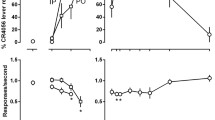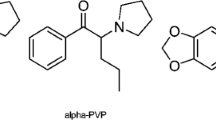Abstract
The discriminative stimulus properties of three β-carboline derivatives were studied in three groups of rats trained, respectively, to discriminate diazepam (2.5 mg/kg IP), chlordiazepoxide (CDP, 5 mg/kg IP) or pentylenetetrazol (PTZ, 15 mg/kg IP) from saline in standard procedures employing two-lever operant chambers. Two β-carbolines, ZK 91296 and ZK 93423, substituted for the benzodiazepines in both CDP- and diazepam-trained rats. The neutral benzodiazepine antagonist Ro 15-1788 blocked the diazepam discriminative stimulus and the ability of ZK 91296 to substitute for diazepam. A third β-carboline, FG 7142, was not identified as benzodiazepine-like in generalization tests in either diazepam- or CDP-trained rats, but when administered together with CDP antagonized the benzodiazepine discriminative stimulus. In rats trained to discriminate PTZ from saline (a discrimination which is thought to depend on the anxiogenic properties of PTZ) the PTZ cue was antagonized by diazepam and ZK 93423, and partially antagonized by ZK 91296. The PTZ cue generalized to FG 7142 and this generalization was partially antagonized by Ro 15-1788. These results suggest that the three β-carbolines provide more than one kind of discriminative stimulus, consistent with the classification of ZK 93423 as an agonist at central benzodiazepine receptors, with ZK 91 296 as a partial agonist, and with FG 7142 as an inverse agonist. Pharmacologically, ZK 93 423 and ZK 91 296 may exhibit anxiolytic qualities, whereas FG 7142 produces anxiogenic effects.
Similar content being viewed by others
References
Braestrup C, Nielsen M, Petersen EN, Honore T, Jensen LH (1983) Benzodiazepine receptor ligands with negative efficacy. Chloride channel coupling. In: Biggio G, Costa E (eds) Advances in biochemical pharmacology, vol 38. Benzodiazepine recognition site ligands: Biochemistry and pharmacology. Raven Press, New York (in press)
Braestrup C, Schmiechen R, Neef G, Nielsen M, Petersen EN (1982) Interaction of convulsive ligands with benzodiazepine receptors. Science 216:1241–1243
Colpaert FC (1977) Discriminative stimulus properties of benzodiazepines and barbiturates. In: Lal H (ed) Discriminative stimulus properties of drugs. Plenum, New York, pp 5–21
Colpaert FC, Desmedt LKC, Janssen PAJ (1976) Discriminative stimulus properties of benzodiazepine, barbiturates and pharmacologically related drugs; relation to some intrinsic and anticonvulsant effects. Eur J Pharmacol 37:113–123
Czernik AJ, Petrack B, Kalinsky HJ, Psychoyos S, Cash WD, Tsai C, Rinehart RK, Granat FR, Lovell RA, Brundish DE, Wade R (1982) CGS 8216: Receptor binding characteristics of a potent benzodiazepine antagonist. Life Sci 30:363–372
Davis NM, Brookes S, Gray JA, Rawlins JNP (1981) Chlordiazepoxide and resistance to punishment. Q J Exp Psychol 33B:227–239
Dorow R, Horowski R, Paschelke G, Amin M, Braestrup C (1983) Severe anxiety induced by FG 7142, a β-carboline ligand for benzodiazepine receptors. Lancet 8341:98–99
Extance K, Goudie AT (1981) Inter-animal olfactory cues in operant drug discrimination procedures in rats. Psychopharmacology 73:363–371
Haug T, Gotestam KG (1981) Two opposite effects of diazepam on fear by differential training in the CER paradigm. Psychopharmacology 75:110–113
Hunkeler W, Mohler H, Pieri L, Pole P, Bonetti EP, Cumin R, Schaffner R, Haefely W (1981) Selective antagonists of benzodiazepines. Nature 290:514–516
Jensen LH, Petersen EN, Braestrup C (1983) Audiogenic seizures in DBA/2 mice discriminate sensitively between low efficacy benzodiazepine receptor agonists and inverse agonists. Life Sci 33:393–399
Jensen LH, Petersen EN, Braestrup C, Honore T, Kehr W, Stephens DN, Schneider H, Seidelmann D, Schmiechen R (1984) Evaluation of the β-carboline ZK 93 426, as a benzodiazepine receptor antagonist. Psychopharmacology 83:249–256
Lal H, Shearman GT (1980) Interoceptive discriminative stimuli in the development of CNS drugs, and a case of an animal model of anxiety. Annual Reports in Medicinal Chemistry 15:51–58
Lal H, Shearman GT (1982) Attenuation of chemically induced anxiogenic stimuli as a novel method for evaluating anxiolytic drugs: a comparison of clobazepam with other benzodiazepines. Drug Development Research Supplement 1:127–134
Little HJ, Nutt DJ (1984) Benzodiazepine contragonists cause kindling (abstract) Br J Pharmacol 81:288
Meldrum B, Evans MC, Braestrup C (1983) Anticonvulsant action in the photosensitive baboon, Papio papio, of a novel β-carboline derivative, ZK 91 296. Eur J Pharmacol 91:255–259
Petersen EN, Jensen LH, Honore T, Braestrup C (1983) Differential pharmacological effects of BZ receptor inverse agonists. In: Biggio G, Costa E (eds) Advances in biochemical pharmacology, vol 38. Benzodiazepine recognition site ligands: Biochemistry and pharmacology. Raven Press, New York (in press)
Petersen EN, Jensen LH, Honore T, Braestrup C, Kehr W, Stephens DN, Wachtel H, Seidelmann D, Schmiechen R (1984) ZK 91 296, a partial agonist at benzodiazepine receptors. Psychopharmacology 83:240–248
Petersen EN, Paschelke G, Kehr W, Nielsen M, Braestrup C (1982) Does the reversal of the anticonflict effect of phenobarbital by β-CCE and FG 7142 indicate benzodizepine receptor-mediated anxiogenic properties? Eur J Pharmacol 82:217–221
Schechter MD (1983) Drug sensitivity of individual rats determines degree of drug discrimination. Pharmacol Biochem Behav 19:1–4
Shearman GT, Lal H (1978) Discriminative stimulus properties of pentylenetetrazol in the rat. In: Colpaert FC, Rosencrans JA (eds) Stimulus properties of drugs: ten years of progress. Elsevier/North Holland, Amsterdam, pp 181–188
Shearman GT, Lal H (1979) Discriminative stimulus properties of pentylenetetrazol and bemegride: Some generalisation and antagonism tests. Psychopharmacology 64:315–319
Shearman GT, Lal H (1980) Generalisation and antagonism studies with convulsant GABAergic and anticonvulsant drugs in rats trained to discriminate pentylenetetrazol from saline. Neuropharmacology 19:473–479
Shearman GT, Lal H (1981) Discriminative stimulus properties of cocaine related to an anxiogenic action. Prog Neuropsychopharmacol 5:57–63
Siegel S (1956) Nonparametric statistics for the behavioral sciences. McGraw-Hill, New York
Squires RF, Braestrup C (1977) Benzodiazepine receptors in rat brain. Nature 266:732–734
Stephens DN, Kehr W, Schneider HH, Schmiechen R (1984) Characterisation of agonist, inverse agonist and partial agonist activities of β-carbolines in a drug-discrimination paradigm (Abstract). Behav Brain Res (in press)
Author information
Authors and Affiliations
Rights and permissions
About this article
Cite this article
Stephens, D.N., Shearman, G.T. & Kehr, W. Discriminative stimulus properties of β-carbolines characterized as agonists and inverse agonists at central benzodiazepine receptors. Psychopharmacology 83, 233–239 (1984). https://doi.org/10.1007/BF00464787
Received:
Accepted:
Issue Date:
DOI: https://doi.org/10.1007/BF00464787




